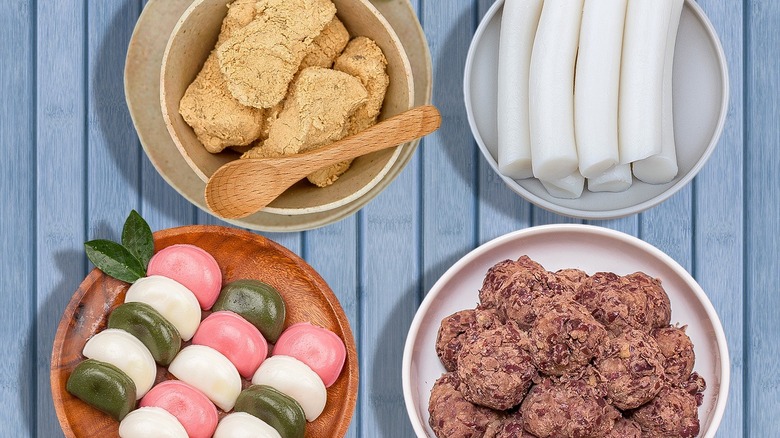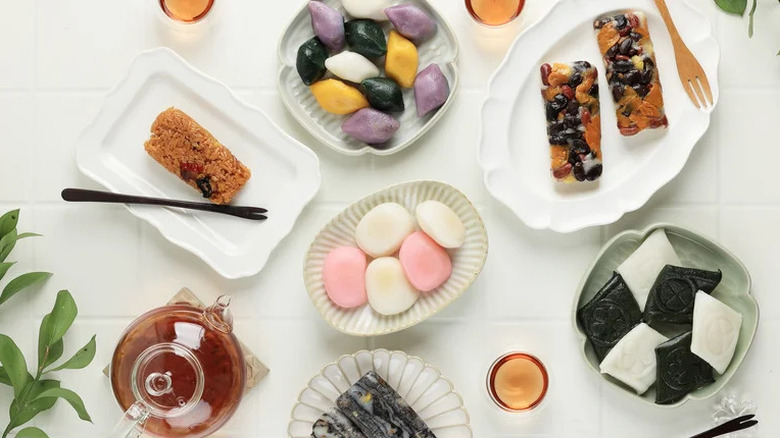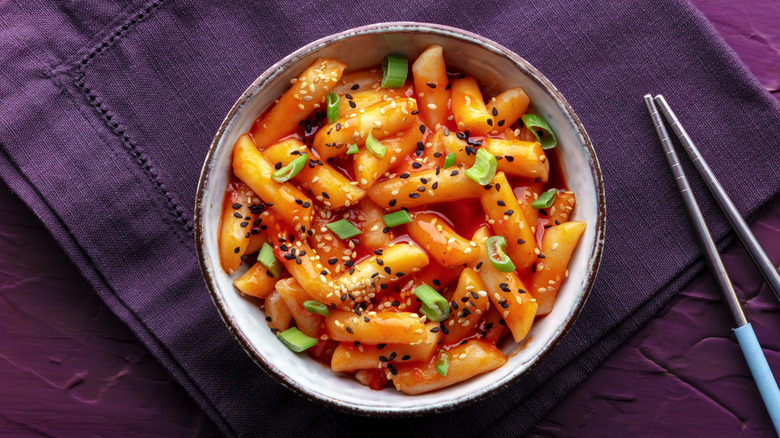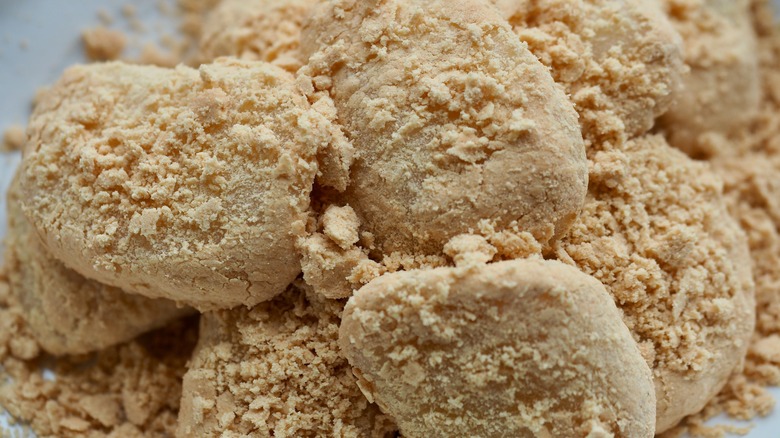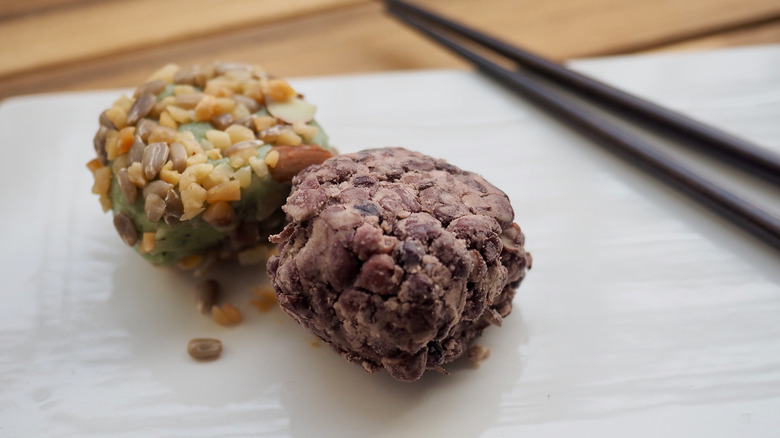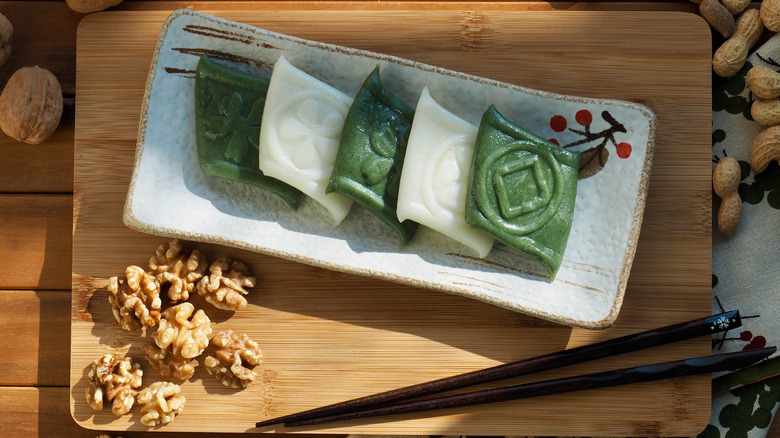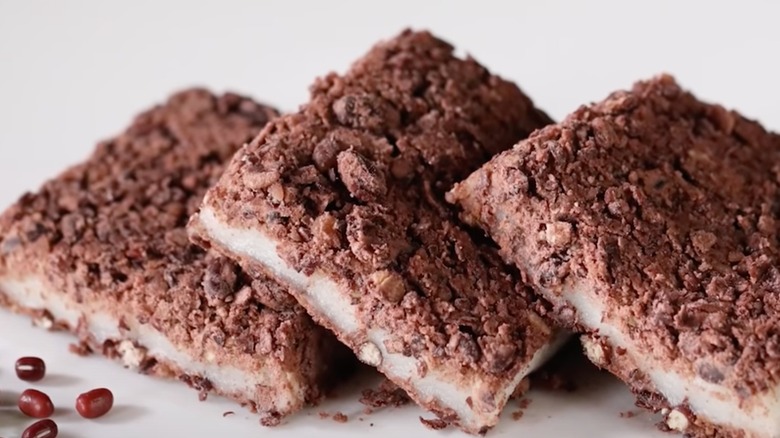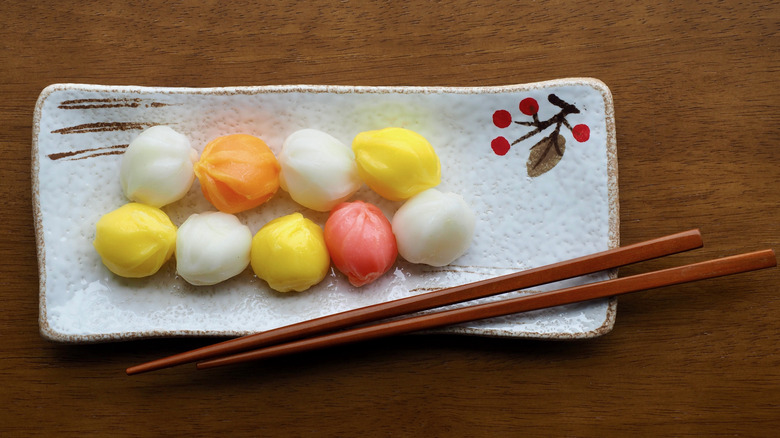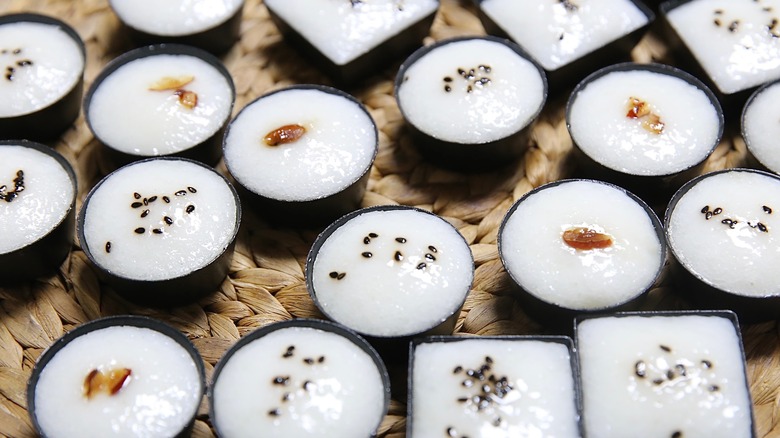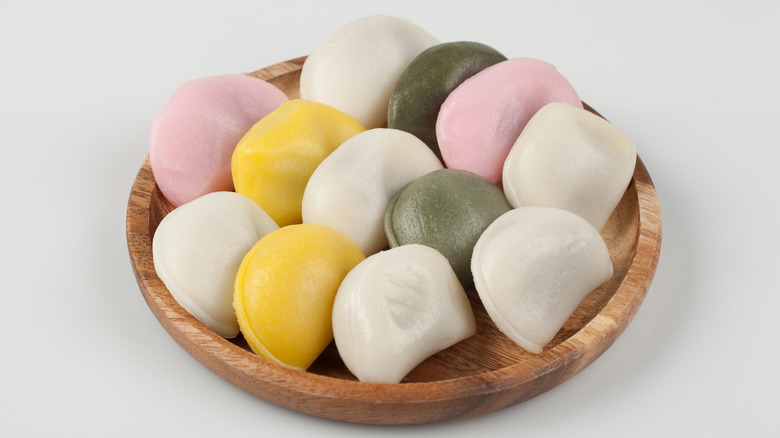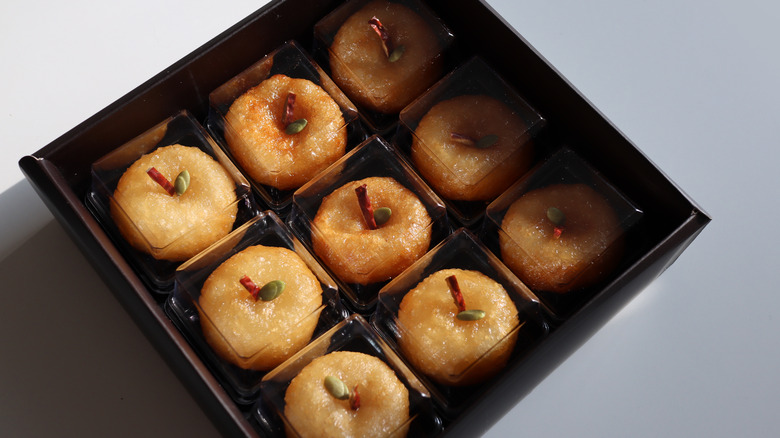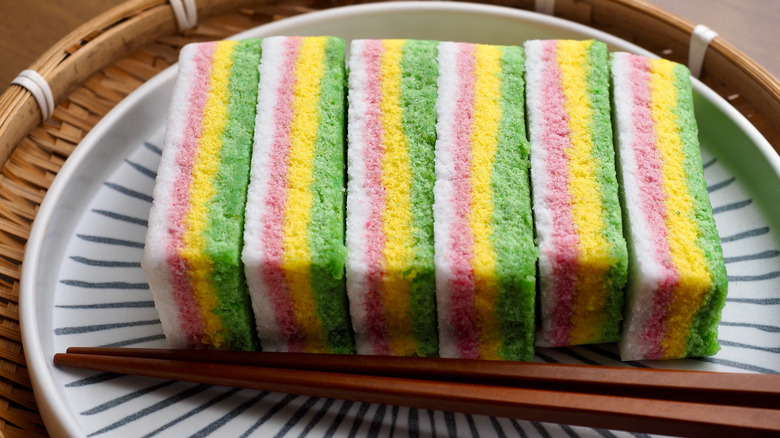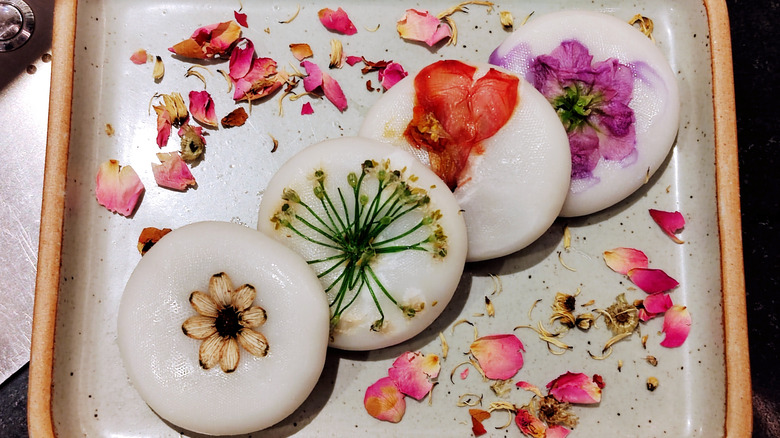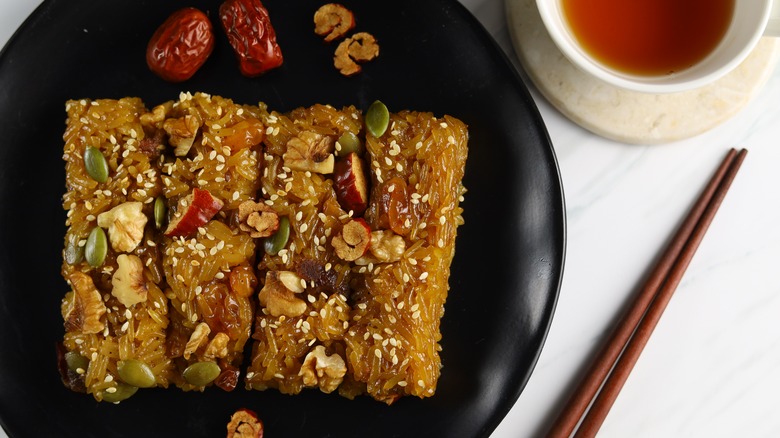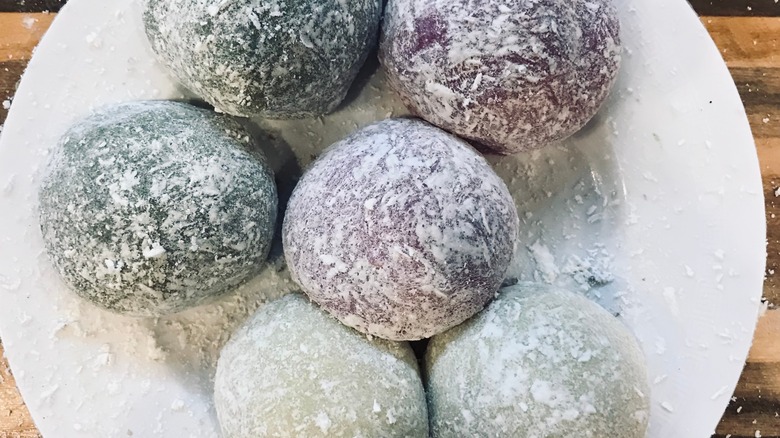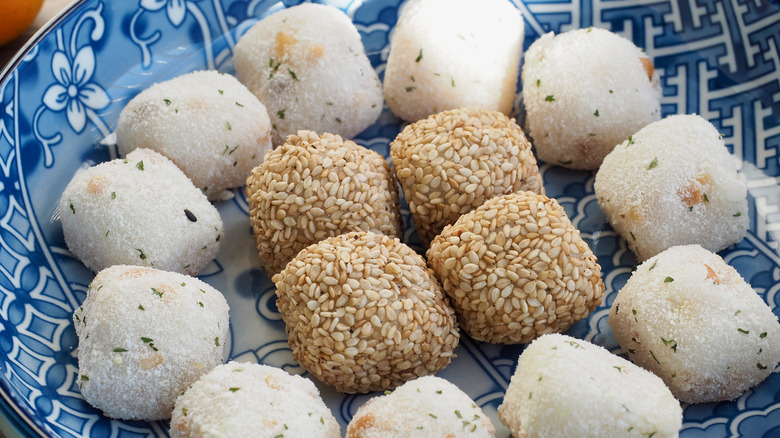15 Popular Types Of Korean Rice Cakes, Explained By Chefs
Endlessly versatile, rice is nature's power move in carb form. We've never met a rice dish we didn't like, and tteok — Korean rice cakes — are no exception. But this is rice on another level. Seemingly imbued with magical powers, Korean rice cakes are touted for bringing wealth, luck, good health, long life, and protection of evil spirits to those who consume them, forming as much a part of cultural celebrations as daily snacking. Got 99 problems? There might just be a rice cake for that.
But rice cakes are much more than a tonic to whatever ails you. Morphing between beloved street food and the auspicious festive fare, they're versatile and community-incarnate. "While making rice cakes, I don't think of them as something I eat alone but as something to share," says Sam (Yul Gu) Lee, a chef at Seoul Night in Auckland, New Zealand. "I always think of my family and imagine sharing them with neighbors or colleagues ... I think rice cakes represent love, sharing, and our national identity."
It'd be impossible to catalog every single Korean rice cake in existence. Nevertheless, we caught up with Lee, along with Julia (Jung A) Park and Cindy (Hyo Jeong) Ryu, a trio of chefs from Auckland New Zealand's hottest Korean dining bar, and gleefully dove head first into the delicious realm of Korean rice cakes.
Rice Cakes 101
There are five main methods to usher the various forms of Korean rice cake into being: pounding, shaping, steaming, pan-frying, and, in the case of just one particular type of rice cake, boiling. Most are made from glutinous rice grains or flour served with a powdered or syrupy coating or filled with everything from the classic evil spirit-repelling red mung bean paste to black sesame, fruit, or nuts.
"Making rice cakes is quite a meticulous task, so it is not commonly a dish that people make at home on a regular basis. However, it is a food that families come together to make on special occasions like holidays," explains Julia Park. Cylindrical garae-tteok and ovals used in tteokguk soup are, today, mostly made by machines although traditionally they were made from scratch. "I have happy memories of making rice cakes at my grandmother's house during Lunar New Year or Chu-seok. We'd all gather together with our extended family to make them," shares Cindy Ryu.
Rice cakes are enjoyed savory and sweet in a myriad of different ways, although you can bet where there are savory rice cakes, gochujang (Korean chili paste) will be nearby. Brought together entirely by accident in a kitchen in the 1950s, rice cakes and the bright orange sauce have since become a power pairing.
Garae-tteok
It feels sacrilegious to consider these chunky white cylinders without being slathered in spicy gochujang — gochujang's long history in Korea is renowned — but the earliest appearance of garae-tteok was served up without a trace of the Korean chili paste. Far from the ubiquitous street food it is today, it exclusively graced the plates of royalty as a cure for illness.
"Royal tteokbokki was a dish once served on the royal table of the king and can be considered traditional tteokbokki," explains Sam Lee. "Although today's versions often include sauces made with gochujang and chili powder, the tteokbokki that was served to ancient kings was made with a soy sauce base, which is different from what is commonly seen today."
Garae-tteok has since exploded and the ways of eating it are numerous. Spicy tteokbokki — rice cakes with fish cake sheets, anchovy broth, green cabbage, scallion, boiled eggs, and gochugaru (Korean red pepper flakes) — remains ever-popular. Equally delectable is tteokguk, a warming traditional Korean Lunar New Year rice cake broth that brings good fortune for the year ahead.
Then there's teok-kkochi — fried, skewered garrae-tteok in a sticky-delicious bright orange sauce— and sotteok sotteok, a Korean street food favorite where rice cakes are skewered with small sausages. Contemporary iterations include topping with gooey mozzarella or rose tteokbokki (paired with cream), and rabokki is where ramyeon noodles and cheese are thrown into the mix. The latter is synonymous with student life, beer, or soju, which are staple drink pairings.
Injeolmi
When you roll steamed, pounded glutinous rice in powdered mugwort or roasted soybean powder, sesame seeds, nuts, or jujube, you get injeolmi. The rice cake is similar in appearance and texture to Chinese muah che and tastes of nuts with a sweetness. A bite-sized treat, it's often served symbolically at weddings due to its sticky texture. The idea is that the newlyweds' love will burn forever, and they'll remain happily stuck together, just like injeolmi.
Injeolmi can be snacked on as is but it also makes a great topping for bingsu, a 'Gram-worthy Korean shaved ice dessert that's equally a feast of textures as it is of flavors. A contemporary way to eat injeolmi, however, is between two slices of bread in somewhat of a salute to s'mores — injeolmi toast. Make it yourself by lining a slice of buttered, honeyed bread with injeolmi cubes. Add more honey, if desired, then grill in a sandwich press or air fryer to melt into a stretchy, gooey delight. Top with a dusting of roasted soybean powder and your favorite toppings.
Omegi-tteok
An anomaly in rice cake lore, omegi-tteok doesn't actually contain any rice (traditionally, it didn't, anyway). It's still, however, widely regarded as a tteok, so it'd be remiss of us to omit it here. Rice wasn't easily come by on Jeju Island, so omegi-tteok is instead made from a type of local millet known as chajo, which is leftover from the production of local liquor, omegi sul.The millet is pounded and shaped into palm-sized cubes before being covered in semi-crushed red mung beans. The result is a rustic, chunky fistful of a rice cake.
Omegi-tteok was originally made as an offering for spiritual rituals and wasn't intended to be eaten, but it now tops the must-eat list for tourists visiting Jeju Island, not least due to its health benefits. Using millet instead of rice makes omegi-tteok the omega of rice cakes — they're rich in protein and complex carbs and are a good source of fiber, healthy fats, phosphorous, calcium, magnesium, folate, and iron.
Jeolpyeon
Line up rectangles of jeolpyeon on a plate, and you could be looking at a patchwork quilt. Another form of pounded rice cake, this one comes in joyful colors — dyed using natural plant-based pigments— and patterns with a sweet red mung bean filling. Delicate and ornate, it's easy to see why jeolpyeon, which was being made as early as 1392, was originally a religious offering. The detailed, time-consuming process of making dyes and dough, followed by hand-shaping and tteoksal (rice cake stamp) selection, is surely a clear demonstration of commitment to a higher power.
Today, it's consumed at weddings, tea ceremonies, ancestral rites, and festivals, or anytime at all. "The long line stamped on the jeolpyeon symbolizes an unbroken, continuous connection representing longevity," says Julia Park. With this in mind, jeolpyeon is perhaps especially useful for recovering from existential crises, dunked in honey, soy sauce, or sesame oil for added self-care, of course.
Sirru-tteok
If you're moving house, starting a business, getting married, or seeing in the Lunar New Year, you'll do well to be armed with several kilos of siru-tteok. "It is one of our traditions to share siru-tteok with your neighbor when you move to a new place to live," explains Cindy Ryu. This steamed, layered rice cake scattered with mashed red beans is cooked in a clay steaming vessel called a siru, which dates back to the Bronze Age.
"One interesting tradition is making white rice cakes for a baby's 100th-day celebration," says Sam Lee, referring to an iteration of siru-tteok called baek-il-tteok or white snow cake.
Baek-il-tteok is made from short-grain rice flour, sugar, water, and salt in the shape of a square or circle, sometimes with a layer of honey in the middle. As Julia Park tells us, "This involves making a dough with rice flour and water, then steaming it without any coloring. It symbolizes the wish for the baby to grow up pure and healthy."
Ryu adds that the tradition arose from a history of high infant mortality rates. "In the past, when medical technology was not as advanced, it was rare for babies to survive beyond 100 days," she says. "So when a baby reached 100 days old, it was a big celebration for the whole village." Accordingly, if rice cakes were shared with 100 people, it was believed that the baby would live to 100 years old.
Ggul-tteok
Resembling petite flower buds, ggul-tteok is a spherical rice cake the size of a walnut. Although the name translates to honey rice cake, traditionally, there isn't actually any honey inside of ggul-tteok; the name refers instead to a traditional rice-based sweetener called jocheong, which ggul-tteok is filled to the brim with.
According to traditional Korean medicine, jocheong fortifies the immune system against illness and provides an energy boost in the face of fatigue thanks to high levels of beta-carotene. Eat in one bite for a wonderful syrupy explosion, reveling in the contrast between the chewy exterior and the liquid saccharine center. Cut the sugar hit (somewhat) by spritzing the balls with citrus syrup and a dusting of soybean flour.
Confusingly, honey rice cakes aren't the same as 'Korean rice cakes with honey.' The latter isn't ggul-tteok at all but cylindrical garae-tteok, grilled, then dipped in jocheong for a blissful (and highly addictive) balance between savory and sweet.
Jeungpyeon
Makgeolli is the star of jeungpyeon rice cakes. The opaque white Korean rice wine is a sweet ferment made from half-steamed rice, yeast, and water, potentially with a savory pairing of pine nuts, chestnuts, or stone mushrooms. When rice wine meets rice flour, you get — via the steamer — a spongey, fluffy texture, which could be why jeungpyeon is served in muffin form or the shape of a loaf. Eat as is or top with a slash of honey or sesame oil.
Rice cakes tend to get snaffled down quickly, partly because they are delicious and partly because vendors strongly recommend eating them on the day of purchase. Jeungpyeon, by virtue of containing rice wine, has a longer shelf life than other types of rice cake, which affords it heat resistance. Consequently, it's a favorite snack when the summer sun is at its hottest. That said, it's unlikely they'll ever stick around long enough for their longevity to be tested.
Songpyeon
If you're lucky enough to be in Korea for the Chu-seok or Mid-Autumn Festival, celebrating with a small feast of brightly-colored songpyeon is essential. Chu-seok sprang from agrarian origins but from a contemporary lens, it celebrates the blossoming relationships between people. Although the shape and fillings vary regionally, songpyeon are classically made in the shape of half-moons or half-circles in a visual representation of a glass-half-full mentality. These heart-warming, vitally important relationships and connections have space to continue to grow and develop into their fullness.
The metaphor for growth continues — even the name summons visuals of tall, thriving pine forests — as 'song' means pine trees. The dough is colored using natural dye powders made from various vegetables, herbs, or dried fruit. Traditionally, once shaped and stuffed with sweetened sesame seeds or red beans, songpyeon would be steamed over a layer of pine needles, infusing them with the unmistakable fragrance of pine.
Songpyeon also features at a baby's 100-day celebration, appearing in five colors and a mix of hollow and filled tteok as a vital component of a dolsang or elaborate table setting. The different colors set the scene for a baby to thrive among diversity, and the hollow and filled tteok suggests the baby will approach others with generosity, gaining plenty of knowledge and wisdom as they journey through life.
Gaeseong Juak
When you're hankering for a donut, nothing else will do, but fortunately, there's a rice cake for that, too. Gaeseong juak are plump spheres of deep-fried dough in miniature, sometimes ringed — dipped in a malt-like ssal-jocheong rice syrup glaze. Decorations range from a single pumpkin seed (which makes them look like tiny pumpkins) to ice cream, cream cheese, or a dusting of colored sugar powder à la classic Americana. Dating back to the Goryeo Dynasty, in the Gaeseong region, the picture-perfect rice cakes may qualify as a culinary relic, but today they're enjoying a Granny-core renaissance.
The key components in gaeseong juak are glutinous rice flour and makgeolli. Once deep fried, they're submerged in jocheong syrup, then left to dredge, forming an ultra-satisfying sugar-kissed crispy exterior. Sink your teeth in, and the delectable fry gives way to a chewy center. The donuts pair well with warm tea, an Americano, or sujeonngwa, a Korean cinnamon drink.
Mujigae-tteok
At first glance, mujigae-tteok looks like a limited-edition novelty for Pride, and while it would be home amongst the festivities, that isn't actually why this rice cake is rainbow. Traditionally, it is a square cake layered with steamed, wet-milled short-grain rice flour that is naturally dyed white, pink, yellow, green, and brown; mujigae-tteok appears at weddings, doljanchi or first birthdays, and hwangapjanchi or 61st birthdays. Why the latter? In Korean culture turning 61 means you've completed five 12-year lunar cycles — a milestone worthy of celebration.
To make mujigae-tteok at home, start by mixing portions of rice flour with your choice of food coloring powders. Next, line a bamboo steamer with a damp cotton cloth and a silicone sheet or piece of cooking paper. Position a ring-shaped cake tin in the center of the steamer and tip the first colored rice flour into the tin; lightly use a spatula to ensure the flour covers the tin evenly without compacting the flour, and repeat with each color. Avoid compacting the flour layers unless you want a dense rather than fluffy cake. Steam until solid (about 8 minutes, depending on the size of your cake).
Hwajeon
Hwajeon, the beautiful fried rice cakes decorated with edible flowers, make a perfect addition to your next picnic spread, for that's exactly how they came to be. Dating back as early as the Goryeo Dynasty, which began in 918 AD, hwajeon comes from a time when women would lug a heavy pan up the mountains for spring picnics called Hwajeon-nori (which translates to 'flower cake play') to revel in the seasonal blooms.
The pancakes themselves are circular, relatively flat, and chewy, drizzled with syrup or honey. The decorations mirror the seasons. Typically, chrysanthemums are used in the autumn; rose petals in summer; azaleas, cherry blossoms, violets, or goldenbells in the spring; and, in a flex of artistic license, mugwort leaves and jujubes cut into flower shapes in the winter. Pair with a beverage made from the same flowers, perhaps a floral-infused honey-water, tea, or, for a lusher tipple, rice wine.
Yaksik
You can power through a hike with a hoard of yaksik. With a caramel hue, this fruit and nut-filled rice brick is rich in vitamins and energy. The medicine cake, as it's known, is made by steaming a mixture of glutinous rice grains, chestnuts, walnuts, pine nuts, jujubes, and cranberries (or any similar combination) with a binder of caramel sugar, cinnamon, soy sauce, and sesame oil. Eat hot with a spoon or let cool and cut into slabs. The latter makes for a handy snack to keep energy levels high.
Legend has it this rice cake was created as a ritual offering by King Soji of Silla Kingdom when a crow saved him from being assassinated over 1,000 years ago. Yaksik is also one of the dishes that define Korean Lunar New Year as a sweet ending, following other celebratory dishes like mandu dumplings, colorful japchae noodles, and fried breaded zucchini.
Chapssal-tteok
If you're experiencing a sudden onslaught of culinary déjà-vu right now, that's because chapssal-tteok looks similar to the Japanese mochi variant, daifuku (here are 16 types of mochi, explained). Delving into the method of making it, however, reveals some major distinctions. "The methods of production are different," says Sam Lee. "In Korea, glutinous rice is ground into a dough, filled with sweetened bean paste, and then steamed. In Japan, mochi is made by pounding soaked glutinous rice."
Chapssal-tteok is chewy and dense, with a thin rice flour-based exterior wrapped around a sweet filling, and ticks all the boxes for a texturally satisfying dessert, a whimsical sweet snack, and just so happens to be a good luck charm for students. Unlike mochi, which is traditionally filled with sweetened red bean paste, chapssal-tteok fillings are broader and could feature things like sesame seeds, mung beans, soybeans, or chestnuts.
Gyeongdan
Boiling rice cakes isn't commonplace unless you're making gyeongdan. Preparing these chestnut-shaped tteok doesn't require a steamer, and there isn't any oil or frying involved, making gyeongdan very easy to whip up. Geyongdan is typically made from glutinous rice flour and may be referred to as chapssalgyeongdan to emphasize the rice flour as opposed to susugyeongdan, which indicates the round cakes have been made with glutinous sorghum flour instead.
Similar to chapssal-tteok, gyeongdan is made from red mung bean paste or powdered sesame enrobed in a thin, silky flour dough. The raw gyeongdan balls are dropped into boiling water to cook. Once they float to the surface, they're fished out and left to cool slightly before being coated in black sesame, seeds, colorful powdered beans, sweet pastes, or coconut, as you'd do with bliss balls. Fresh gyeongdan can be eaten immediately, stored in the refrigerator until needed, or frozen for an on-demand snack.
